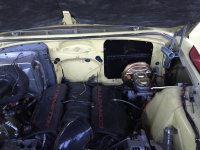Hi All,
I would like to improve the brake system to augment the safety on my Super 1951 Riviera Sedan in moving from the single chamber master cylinder to a dual one and a proportioning valve. This in the objective to separate front and rear brake circuits to still have brake power, should one fails. Apart from that, I plan to keep the rest genuine, being drum-drum.
What would be your part of choice to achieve that for the MC and valve ?
I went to some online supplier but choice is very large and i don't know what would be the best pick.
Thanks in advance for sharing your recommendations.
Bio.
I would like to improve the brake system to augment the safety on my Super 1951 Riviera Sedan in moving from the single chamber master cylinder to a dual one and a proportioning valve. This in the objective to separate front and rear brake circuits to still have brake power, should one fails. Apart from that, I plan to keep the rest genuine, being drum-drum.
What would be your part of choice to achieve that for the MC and valve ?
I went to some online supplier but choice is very large and i don't know what would be the best pick.
Thanks in advance for sharing your recommendations.
Bio.



